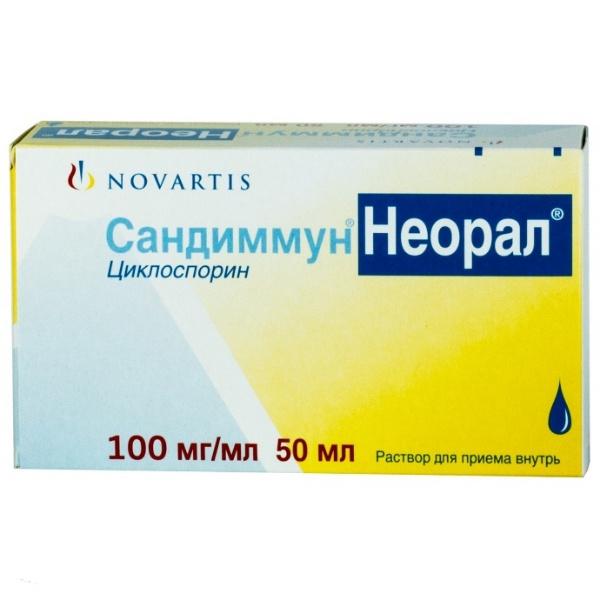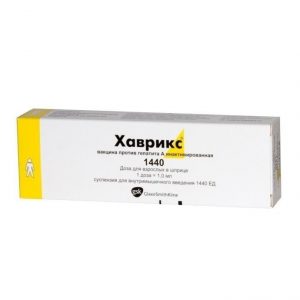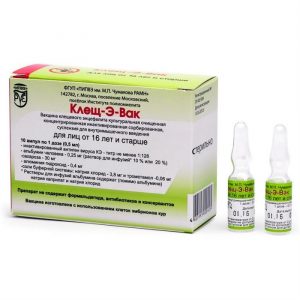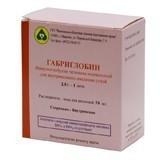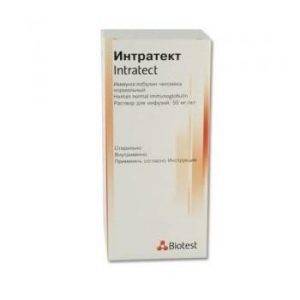Description
Packaging 50ml mlrd
Pharmacological action
SANDIMMUN NEORAL – an immunosuppressive drug, is a cyclic polypeptide consisting of 11 amino acids. Cyclosporin is a selective immunosuppressant that inhibits the activation of calcineurin lymphocytes in the G0 or G1 phase of the cell cycle. Thus, activation of T-lymphocytes and, at the cellular level, antigen-dependent release of lymphokines, including interleukin 2 (T-lymphocyte growth factor), is prevented. Cyclosporin acts on lymphocytes specifically and reversibly. Unlike cytostatics, it does not suppress hematopoiesis and does not affect the function of phagocytes.
Cyclosporine increases the life time of allogeneic grafts of the skin, heart, kidneys, pancreas, bone marrow, small intestine, and lungs. Cyclosporin also inhibits the development of cellular reactions in relation to an allograft, delayed-type skin hypersensitivity reactions, experimental allergic encephalomyelitis, Freund’s adjuvant arthritis, graft versus host disease (GVHD) and T-cell-dependent antibody production. The effectiveness of Sandimmune has been shown in transplantation of bone marrow and solid organs in humans for the prevention and treatment of rejection and GVHD, as well as in the treatment of various conditions that are inherently autoimmune or can be considered as such.
Dosage forms of Sandimmun Neoral (oral solution and soft capsules, in which the solution is also enclosed) have the following feature. The solution is a microemulsion preconcentrate that forms a microemulsion in the presence of a liquid (the liquid with which the oral solution is mixed before administration or in the presence of liquids in the stomach when taking the drug in capsule form). Due to this, the variability of the pharmacokinetic parameters decreases and a linear relationship between the dose and the effect of cyclosporine with a more uniform absorption profile and less dependence on simultaneous food intake is ensured. When studying the microemulsion preconcentrate, it was shown that the correlation between the basal concentration of cyclosporine and its action is more pronounced when using Sandimmune Neoral, than Sandimmuna.
Indications
Transplantation of solid organs (kidney, liver, heart, cardiopulmonary complex, lungs, pancreas) and bone marrow endogenous uveitis, nephrotic syndrome, severe forms of rheumatoid arthritis in the active phase, severe forms of psoriasis and atopic dermatitis.
Contraindications
Hypersensitivity (including to polyoxyethylated castor oil – for dosage forms containing it) malignant neoplasms, precancerous skin diseases childhood (up to 1 year), lactation, childhood (for use in the treatment of psoriasis and rheumatoid arthritis).
Caution. Chicken pox (currently or recently suffered, including recent contact with the patient), Varicella zoster (risk of generalization of the process) and other viral diseases, renal and / or liver failure, hyperkalemia, arterial hypertension, infections, malabsorption syndrome.
Use during pregnancy and lactation
Experience with Sandimmun Neoral in pregnant women is limited. Pregnant women who have undergone organ transplantation and are receiving immunosuppressive medication are at increased risk of premature birth. There is a limited number of observations of children (up to the age of 7 years) exposed to cyclosporine during prenatal development. Renal function and blood pressure in these children were normal. However, adequate and well-controlled studies in pregnant women have not been conducted, therefore, Sandimmun Neoral should not be used during pregnancy, unless the expected benefit to the mother justifies the potential risk to the fetus.
In experimental studies, the toxic effect of the drug on reproductive function is shown.
Cyclosporine passes into breast milk. Mothers receiving Sandimmune Neoral should stop breastfeeding.
Special instructions
Sandimmun Neoral should only be used by doctors who are experienced in immunosuppressive therapy and are able to provide adequate follow-up, including regular physical examination, blood pressure measurements, and serum creatinine concentration monitoring. Monitoring patients who have undergone transplantation and are receiving the drug should be carried out only in those institutions that are equipped with trained medical personnel, adequate laboratory and other resources.
It should be borne in mind that with the use of cyclosporine, as well as other immunosuppressants, the risk of developing lymphomas and other malignant neoplasms increases, more often skin integument. An increased risk of developing this complication is associated more with the degree and duration of immunosuppression than with the use of a particular drug. Thus, caution should be exercised when using combined modes of immunosuppressive therapy, bearing in mind the likelihood of developing lymphoproliferative diseases and solid organ tumors, sometimes leading to fatal outcomes.
The use of cyclosporine, like other immunosuppressants, predisposes to the development of various bacterial, fungal, parasitic and viral infections, often with the participation of opportunistic pathogens. Given the potential danger of these infections to the patient ² ¢s life, an effective system of preventive and therapeutic measures should be used, especially in cases of prolonged use of combined immunosuppressive treatment.
During the first few weeks of Sandimmun Neoral therapy, a frequent and potentially dangerous complication may appear – an increase in serum creatinine and urea. These functional changes are reversible and dose-dependent, normalizing when the dose is reduced. With prolonged treatment, some patients may develop structural changes in the kidneys (for example, interstitial fibrosis), which in patients with renal transplants should be differentiated from those with chronic rejection. Sandimmune Neoral may also cause a dose-dependent reversible increase in serum bilirubin and, rarely, liver enzymes. In these cases, careful monitoring of renal and hepatic function is required. In case of deviations of these indicators from the norm, a dose reduction may be required.
To control the concentration of cyclosporin in the blood, it is preferable to use specific monoclonal antibodies (measuring the amount of unchanged drug). You can use the HPLC method, which also measures the concentration of unchanged substance. If plasma or serum is used, then the standard separation procedure (time and temperature) should be followed. For the initial determination of cyclosporine concentration in patients with liver transplants, specific monoclonal antibodies should be used. It is also possible to conduct parallel determinations using specific and non-specific monoclonal antibodies, to achieve a dose that provides adequate immunosuppression.
It should be remembered that the concentration of cyclosporine in the blood, plasma or serum is only one of many factors that characterize the clinical condition of the patient. The results of determining the concentration of cyclosporine are only one of the factors determining the dosage regimen, and are considered in conjunction with various clinical and laboratory parameters.
Regular monitoring of blood pressure is required with Sandimmun Neoral. With an increase in blood pressure, appropriate antihypertensive therapy should be prescribed.
Influence on the ability to drive vehicles and operate machinery
There is currently no data on the impact of Sandimmun Neoral on the ability to drive and operate machinery.
Composition
1 ml contains cyclosporine 100 mg
Dosage and administration of
Sandimmune-Neoral is taken orally: for adults with a solid organ transplant, treatment should be started 12 hours before surgery at a dose of 10-15 mg / kg, divided into 2 doses. Within 1-2 weeks after surgery – daily, in the same dose, after which the dose is gradually reduced (5% / week) until the maintenance dose is reached – 2-6 mg / kg / day. When prescribed in combination with GCS or other immunosuppressants, lower doses are used (3-6 mg / kg / day in the initial phase of treatment). In bone marrow transplantation – on the day preceding the transplantation, and in the transplantation period, for 2 weeks, in a daily dose of 12.5-15 mg / kg, then they switch to maintenance therapy at a dose of about 12.5 mg / kg / day (with impaired absorption higher oral doses will be required or a switch to iv administration). Maintenance treatment is continued for at least 3-6 months (preferably 6 months), after which the dose is gradually reduced so that 1 year after transplantation, treatment is stopped. In some patients, after cessation of treatment, a rejection reaction develops, in which case treatment should be resumed. In case of endogenous uveitis, for the induction of remission – in the initial daily dose of 5 mg / kg, in 1 or several doses, until the inflammation subsides and the visual acuity improves. In severe cases, the dose can be increased to 7 mg / kg / day for a limited period. During maintenance therapy, the dose should be slowly reduced to achieve the lowest effective dose, which should not exceed 5 mg / kg / day during the period of remission of the disease. In nephrotic syndrome, for the induction of remission, in a daily dose of 5 mg / kg for adults and 6 mg / kg for children (in 2 doses), provided that there is no decrease in renal function (except in cases of proteinuria).
Side effects of
Many side effects associated with the use of cyclosporine are dose-dependent and reversible when the dose is reduced. The spectrum of side effects is generally the same for different indications, although the frequency and severity of side effects may vary. In patients who underwent transplantation, due to a higher dose and a longer duration of treatment, side effects are more common and usually more pronounced than in patients with other indications.
Frequency of side effects: very often -? 10% often – from? 1% to <10% sometimes - from? 0.1% to <1% rarely - from? 0.01% to < 0.1% is very rare - <0.01%. From the urinary system: Very often – impaired renal function. From the cardiovascular system: Very often – increased blood pressure. From the side of the central nervous system and peripheral nervous system: Very often – tremors, headaches often – Paresthesias sometimes – signs of encephalopathy, for example, cramps, lethargy, disorientation, slow reactions, agitation, sleep disturbance, visual disturbances, cortical blindness, coma, paresis, cerebellar ataxia is rare – motor polyneuropathy is very rare – swelling of the optic nerve disk (including the optic nerve papilla), secondary to benign intracranial hypertension. From the digestive system: Often – Anorexia, nausea, vomiting, abdominal pain, diarrhea, gingival hyperplasia, impaired liver function rarely – pancreatitis. From the side of metabolism: Very often – hyperlipidemia often – hyperuricemia, hyperkalemia, hypomagnesemia rarely – hyperglycemia. From the musculoskeletal system Often – muscle cramps, Myalgia rarely – muscle weakness, myopathy. From the hemopoietic system: Sometimes – anemia, rarely thrombocytopenia – microangiopathic hemolytic anemia, hemolytic uremic syndrome. Dermatological reactions: Often – hypertrichosis, sometimes – an allergic rash. On the part of the body as a whole: Often – fatigue sometimes – swelling, weight gain. From the endocrine system: Rarely – violation of menstrual qi Very often – hyperlipidemia often – hyperuricemia, hyperkalemia, hypomagnesemia rarely – hyperglycemia. From the musculoskeletal system Often – muscle cramps, Myalgia rarely – muscle weakness, myopathy. From the hemopoietic system: Sometimes – anemia, rarely thrombocytopenia – microangiopathic hemolytic anemia, hemolytic uremic syndrome. Dermatological reactions: Often – hypertrichosis, sometimes – an allergic rash. On the part of the body as a whole: Often – fatigue sometimes – swelling, weight gain. From the endocrine system: Rarely – violation of menstrual qi Very often – hyperlipidemia often – hyperuricemia, hyperkalemia, hypomagnesemia rarely – hyperglycemia. From the musculoskeletal system Often – muscle cramps, Myalgia rarely – muscle weakness, myopathy. From the hemopoietic system: Sometimes – anemia, rarely thrombocytopenia – microangiopathic hemolytic anemia, hemolytic uremic syndrome. Dermatological reactions: Often – hypertrichosis, sometimes – an allergic rash. On the part of the body as a whole: Often – fatigue sometimes – swelling, weight gain. From the endocrine system: Rarely – violation of menstrual qi Myalgia is rare – muscle weakness, myopathy. From the hemopoietic system: Sometimes – anemia, rarely thrombocytopenia – microangiopathic hemolytic anemia, hemolytic uremic syndrome. Dermatological reactions: Often – hypertrichosis, sometimes – an allergic rash. On the part of the body as a whole: Often – fatigue sometimes – swelling, weight gain. From the endocrine system: Rarely – violation of menstrual qi Myalgia is rare – muscle weakness, myopathy. From the hemopoietic system: Sometimes – anemia, rarely thrombocytopenia – microangiopathic hemolytic anemia, hemolytic uremic syndrome. Dermatological reactions: Often – hypertrichosis, sometimes – an allergic rash. On the part of the body as a whole: Often – fatigue sometimes – swelling, weight gain. From the endocrine system: Rarely – violation of menstrual qi Often – fatigue sometimes – swelling, weight gain. From the endocrine system: Rarely – violation of menstrual qi Often – fatigue sometimes – swelling, weight gain. From the endocrine system: Rarely – violation of menstrual qiCla, gynecomastia. overdose Symptoms: experience with overdosage of Sandimmun Neoral is limited. The development of renal dysfunction is likely, which is likely to be reversible upon discontinuation of the drug. Ingestion of cyclosporine at doses up to 10 g (about 150 mg / kg) in most cases, there were minor clinical manifestations such as vomiting, dizziness, headache, tachycardia. In some cases, reversible impairment of renal function of moderate extent was observed. However, in the case of accidental parenteral overdose of cyclosporine in preterm infants in the neonatal period, the development of severe toxic complications has been reported. Treatment: symptomatic therapy, no specific antidote exists. During the first 2 hours after ingestion, the drug can be removed from the body by vomiting or by gastric lavage. Cyclosporine is virtually not excreted in hemodialysis and hemoperfusion using activated carbon. Storage conditions The product should be stored out of the reach of children, at a temperature not exceeding 30 ° C. Shelf life 3 years. Possible product names SANDIMMUN NEORAL RR D / PR. INSIDE 100MG / ML FL. T / S. 50ML (COMPLETE WITH THE SPINNER. COVER., PDS MERN., TRU SANDIMMUN NEORAL RR D / RECEPTION INSIDE 100MG / ML FL. 50ML (05.08) Sandimmune Neoral oral solution 100mg / ml 50ml Sandimmune Neoral oral 100mg / ml, 50ml Sandimmune neoral 100mg / ml oral solution 50ml Fl./t / s kit / X1 B M (R) Novartis Farma Stein AG, Switzerland
